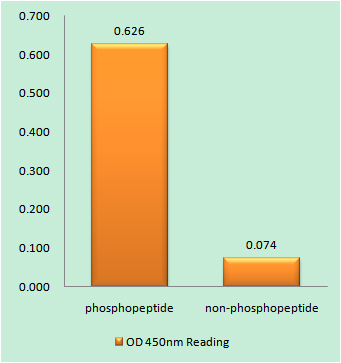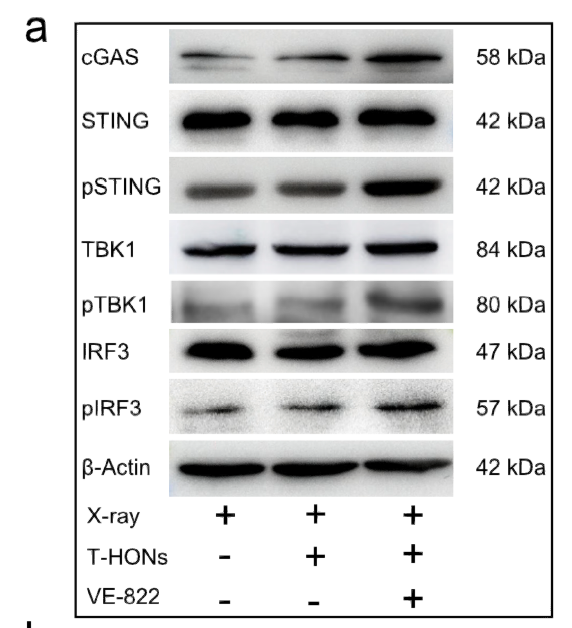Phospho IRF-3 (S385) Cell-Based Colorimetric ELISA Kit
- Catalog No.:KA1291C
- Applications:ELISA
- Reactivity:Human
- Gene Name:
- IRF3
- Human Gene Id:
- 3661
- Human Swiss Prot No:
- Q14653
- Mouse Swiss Prot No:
- P70671
- Storage Stability:
- 2-8°C/6 months
- Other Name:
- Interferon regulatory factor 3 (IRF-3)
- Detection Method:
- Colorimetric
- Background:
- function:Mediates interferon-stimulated response element (ISRE) promoter activation. Functions as a molecular switch for antiviral activity. DsRNA generated during the course of an viral infection leads to IRF3 phosphorylation on the C-terminal serine/threonine cluster. This induces a conformational change, leading to its dimerization, nuclear localization and association with CREB binding protein (CREBBP) to form dsRNA-activated factor 1 (DRAF1), a complex which activates the transcription of genes under the control of ISRE. The complex binds to the IE and PRDIII regions on the IFN-alpha and IFN-beta promoters respectively. IRF-3 does not have any transcription activation domains.,PTM:Constitutively phosphorylated on many serines residues. C-terminal serine/threonine cluster is phosphorylated in response of induction by IKBKE and TBK1. Ser-385 and Ser-386 may be specifically phosphorylated in response to induction. An alternate model propose that the five serine/threonine residues between 396 and 405 are phosphorylated in response to a viral infection. Phosphorylation, and subsequent activation of IRF3 is inhibited by vaccinia virus protein E3.,similarity:Belongs to the IRF family.,similarity:Contains 1 tryptophan pentad repeat DNA-binding domain.,subcellular location:Shuttles between cytoplasmic and nuclear compartments, with export being the prevailing effect. When activated, IRF3 interaction with CREBBP prevents its export to the cytoplasm.,subunit:Homodimer; phosphorylation-induced. Interacts with CREBBP. May interact with MAVS. Interacts with IKBKE and TBK1. Interacts with TICAM1 and TICAM2. Interacts with rotavirus A NSP1 (via C-terminus); this interaction leads to the proteasome-dependent degradation of IRF3.,tissue specificity:Expressed constitutively in a variety of tissues.,
- Function:
- cytokine production, response to molecule of bacterial origin, transcription, transcription, DNA-dependent, regulation of transcription, DNA-dependent, transcription from RNA polymerase II promoter, cell surface receptor linked signal transduction, intracellular signaling cascade, protein kinase cascade, I-kappaB kinase/NF-kappaB cascade, response to virus, response to bacterium, response to organic substance, lipopolysaccharide-mediated signaling pathway,response to lipopolysaccharide, type I interferon production, RNA biosynthetic process, cytokine biosynthetic process,cytokine metabolic process, response to exogenous dsRNA, response to dsRNA, type I interferon biosynthetic process,regulation of transcription, regulation of RNA metabolic process,
- Subcellular Location:
- Cytoplasm . Nucleus . Mitochondrion . Shuttles between cytoplasmic and nuclear compartments, with export being the prevailing effect (PubMed:10805757). When activated, IRF3 interaction with CREBBP prevents its export to the cytoplasm (PubMed:10805757). Recruited to mitochondria via TOMM70:HSP90AA1 upon Sendai virus infection (PubMed:25609812). .
- Expression:
- Expressed constitutively in a variety of tissues.
- June 19-2018
- WESTERN IMMUNOBLOTTING PROTOCOL
- June 19-2018
- IMMUNOHISTOCHEMISTRY-PARAFFIN PROTOCOL
- June 19-2018
- IMMUNOFLUORESCENCE PROTOCOL
- September 08-2020
- FLOW-CYTOMEYRT-PROTOCOL
- May 20-2022
- Cell-Based ELISA│解您多样本WB检测之困扰
- July 13-2018
- CELL-BASED-ELISA-PROTOCOL-FOR-ACETYL-PROTEIN
- July 13-2018
- CELL-BASED-ELISA-PROTOCOL-FOR-PHOSPHO-PROTEIN
- July 13-2018
- Antibody-FAQs


